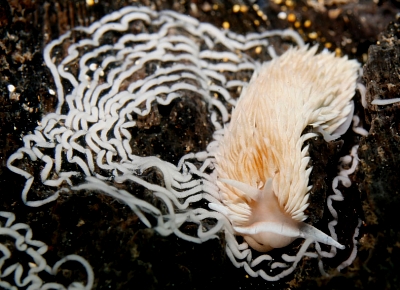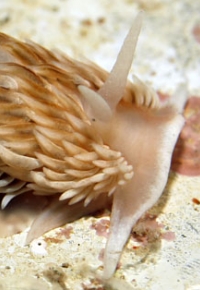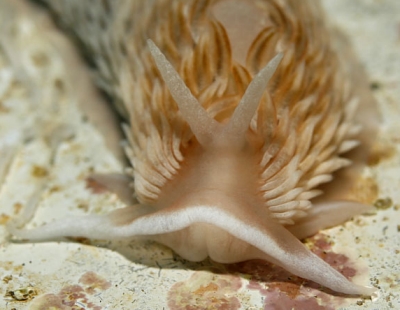Recent Sighting of Aeolidiella drusilla
November 22, 2007
From: Ron Greer

I recently dived Flinders Pier for the first time in many years and found a nudibranch I had not seen before. I believe it is Aeolidiella drusilla as identified from Neville Coleman's 1001 Nudibranchs. I also had a look in this site for more imformation and noted that they had not been seen for some years so I thought you may wish to know that there back. Perhaps they are only seen during egg laying and apparenly staying around the eggs for a period.
Locality: Flinders Pier, Western Port Bay, 5 m, Victoria, Australia, 09 September 2007, Mixed Sand and Mud.. Length: 40 mm. Photographer: Ron Greer.
There were many (12-15 seen) around, always under something in the dark and all were associated with eggs. They were also very light sensitive - even those on overturned rocks in the shade of the pier quickly headed for the edge of the rock and vitual darkeness.
The first 2 images were on sheet of broken building material, probably cement sheet, which would explain the nearly white background colour. The 3rd image was on a more natural background and shows a more direct association with the eggs.
Regards
Ron Greer
diveimage@netspace.net.au



Dear Ron,
Thanks for the nice photos. They give me a chance to do a little house-keeping on the Forum and remove the 'cf' from Aeolidiella drusilla which I had added to the name as I had doubts about the real identity of Australian animals. However, since I wrote the Fact Sheet, Michael Miller published a paper on the New Zealand species of the family and his anatomical studies show that New Zealand specimens, on which the name is based, are identical to Australian animals.
I am not sure why this species is sometimes abundant and at other times very rare. One possibility is that the light sensitivity you mention indicates that it hides during the daytime and so is only found by diligent searching.
Best wishes,
Bill Rudman
Related messages
-
Re: Aeolidiella faustina or A. drusilla?
From: Bill Rudman, November 22, 2007 -
How did Aeolidiella drusilla get its name
From: Drusilla, May 31, 2002 -
Aeolidiella faustina or A. drusilla?
From: Glenys Greenwood, April 14, 2001 -
Aeolid from Victoria, Australia
From: John Chuk, February 6, 2001
